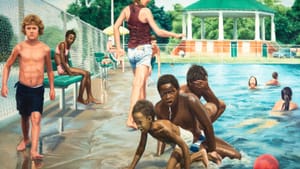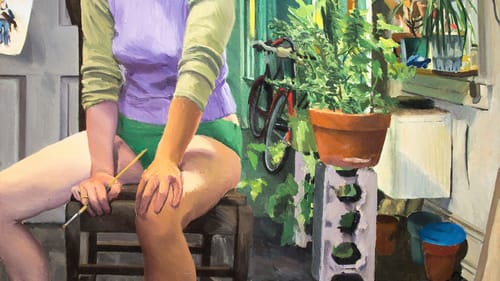Stay in the Loop
BSR publishes on a weekly schedule, with an email newsletter every Wednesday and Thursday morning. There’s no paywall, and subscribing is always free.
Painting life in Philly
Woodmere Art Museum presents ‘Our Town: A Retrospective of Edith Neff’

Step into Edith Neff’s world through images she made of family, friends, and her hometown in Our Town: A Retrospective of Edith Neff. The Philadelphia artist’s large oil canvases transform three Woodmere Art Museum galleries into a life-size photo album.
Neff (1943-1995) painted what she saw, noticing every detail. Edith and her two sisters were exposed to, and encouraged in, the arts by their mother Ruth and father William Ernest Smith, a music critic for The Philadelphia Bulletin and The Public Ledger. Edith went on to study at Philadelphia College of Art (now the University of the Arts), and serve on its faculty, as well as that of the Pennsylvania Academy of Fine Arts.
Raiding the family album
Like Thomas Eakins, Neff used photography for inspiration and documentation. Sometimes she reproduced whole photos, as with Dining Room (1966), in which the family sits around the table: Ruth stands at left, greeting the viewer, while sisters Dorothy and Maria, Edith’s husband Albert Neff, and Maria’s boyfriend are seated. The family cat curls under a chair. Neff’s father, though deceased, is included through a portrait on the wall. No food is being served, and no one smiles. It feels as though we’ve interrupted a family meeting.
Our Town is an intimate view of the person behind the art because it was sponsored by her sister, Dr. Maria Smith, and organized by a close friend, painter Bill Scott. Plenty of supplementary information is provided in the gallery, including photographs, anecdotes, and a 1988 radio interview with the artist, available at a listening station. These inclusions are especially valuable for those unfamiliar with Neff.
Summer at the rec center
Though the artist isn’t widely known, Neff’s subjects are recognizable to anyone from Philadelphia. In addition to reproducing individual photos she or others had shot, Neff also made photographic studies of subjects, combining individual elements into comprehensive images.
Swimming Pool at Hunting Park (1975-1976) is drawn from two summers Neff spent at a rec center that, unlike many Philadelphia pools at the time, really embodied desegregation, serving a diverse public. It’s a joyous vision of summer relief, and Neff places viewers close enough to get wet. It’s midday and children are everywhere: A goggled girl launches herself from the middle of the pool, mouth wide open, while a commanding adolescent strides along the concrete and a boy sunbathes on a bench. Water spills over the edge as three African American boys clamber out, a graceful fan of torsos balanced on a lip of concrete.
A chain-link fence rings the pool. Neff has rendered it so meticulously that you notice, in a way you hadn’t before, how the links turn into a shimmering curtain when viewed sidelong. It’s a detail that reveals her skill.
Living in West Philly
When she won a mural commission from University City Science Center, Neff walked and biked through West Philadelphia with her camera. “I like to create what I call a real space or a natural space in the painting, and so the landscapes are as important as the figures are,” she said in a 1988 interview. The background came first in Mural Commission for Lobby of 3624 Market Street (October 1973-March 1974), then Neff sketched in 25 neighbors of all sorts. Seen in a glass-enclosed lobby, its original site, the colorful streetscape must have appeared as an extension of the neighborhood.
At Woodmere, the mural’s three 10-foot panels instantly transport viewers to West Philadelphia in summer. Kids astride bikes congregate by a telephone pole while others play baseball. A mother and truck-toting toddler stroll by. Young adults meet by chance and pause to chat. An older man grips a bottle in a brown paper bag. Neff inserted her mother in front of a brick row home, and her husband steps off a curb.

The work creates a visceral feel for anyone who’s spent summer in the city, and specifically, this neighborhood. None of the sidewalks match—concrete abuts red bricks in a herringbone pattern, a green postal relay box sits at the corner, the small park is unadorned, streets are narrow, and there are multiple sets of front steps.
Part of the picture
Classical paintings were also a resource for Neff, who consulted masters’ handling of positioning, balance, and light. Sic Transit Gloria Mundi (1995), her last painting before succumbing to cancer at 51, references Jacques-Louis David’s Belisarius Begging for Alms (1781). In Neff’s version, the Roman general-cum-beggar is a man in the park, sitting on a folding chair, with an upturned hat.
Self-Portrait (1978), one of many she made, is modeled on a 17th-century Peter Paul Rubens portrait of his wife, Helena Fourment. Neff stands at an angle, nude save for a fur she holds loosely with her left hand, paintbrush in her right. She looks ahead matter-of-factly, as though checking her reflection. The setting is detailed, from board floors and the oriental rug on which she stands to the room beyond, where canvases lean against a wall.
No matter the pose or what she wears (or doesn’t), Neff’s gaze is unchanging—direct, unapologetic, confident—as if to say, “Here I am.” She depicted herself as she was at every stage of life. The portraits are as visually candid as any photograph.
Whether reproducing family snapshots, combining photographs on canvas, reinventing old masterworks, or putting a here-and-now spin on mythology as she did in Allegory (1974-1975)—putting a nude man and male sheep on Atlantic City’s beach, perhaps as a symbolic reference to the satyr and sensuality—Neff’s large works assume viewers are part of the picture. The familiarity and normality of her subjects remind us that art need not be exalted and remote. It can be a cherished snapshot, a memory we carry in our minds, and even what we see in the mirror.
What, When, Where
Our Town, A Retrospective of Edith Neff. Through January 19, 2020, at Woodmere Art Museum, 9201 Germantown Ave., Philadelphia. (215) 247-0476 or woodmereartmuseum.org.
All Woodmere galleries are wheelchair accessible, with the exception of the Dorothy del Bueno balcony. Accessible parking is available near the Widener Studio building, to the right of the museum, separate from the main parking area. Wheelchairs are available on request. For information and additional assistance, call the museum prior to visiting.
Sign up for our newsletter
All of the week's new articles, all in one place. Sign up for the free weekly BSR newsletters, and don't miss a conversation.
